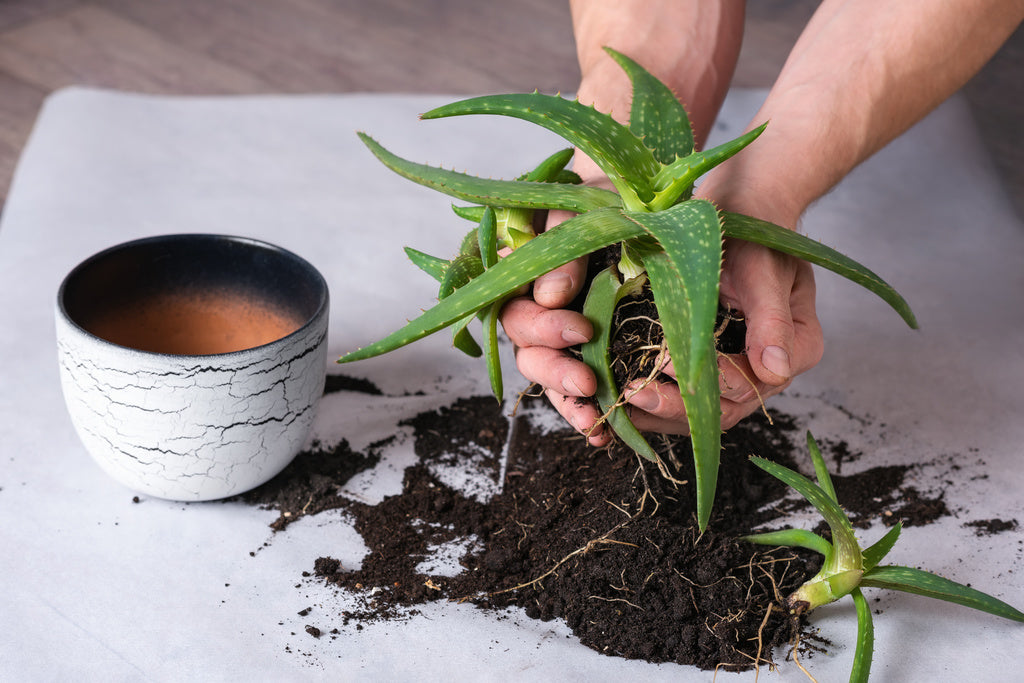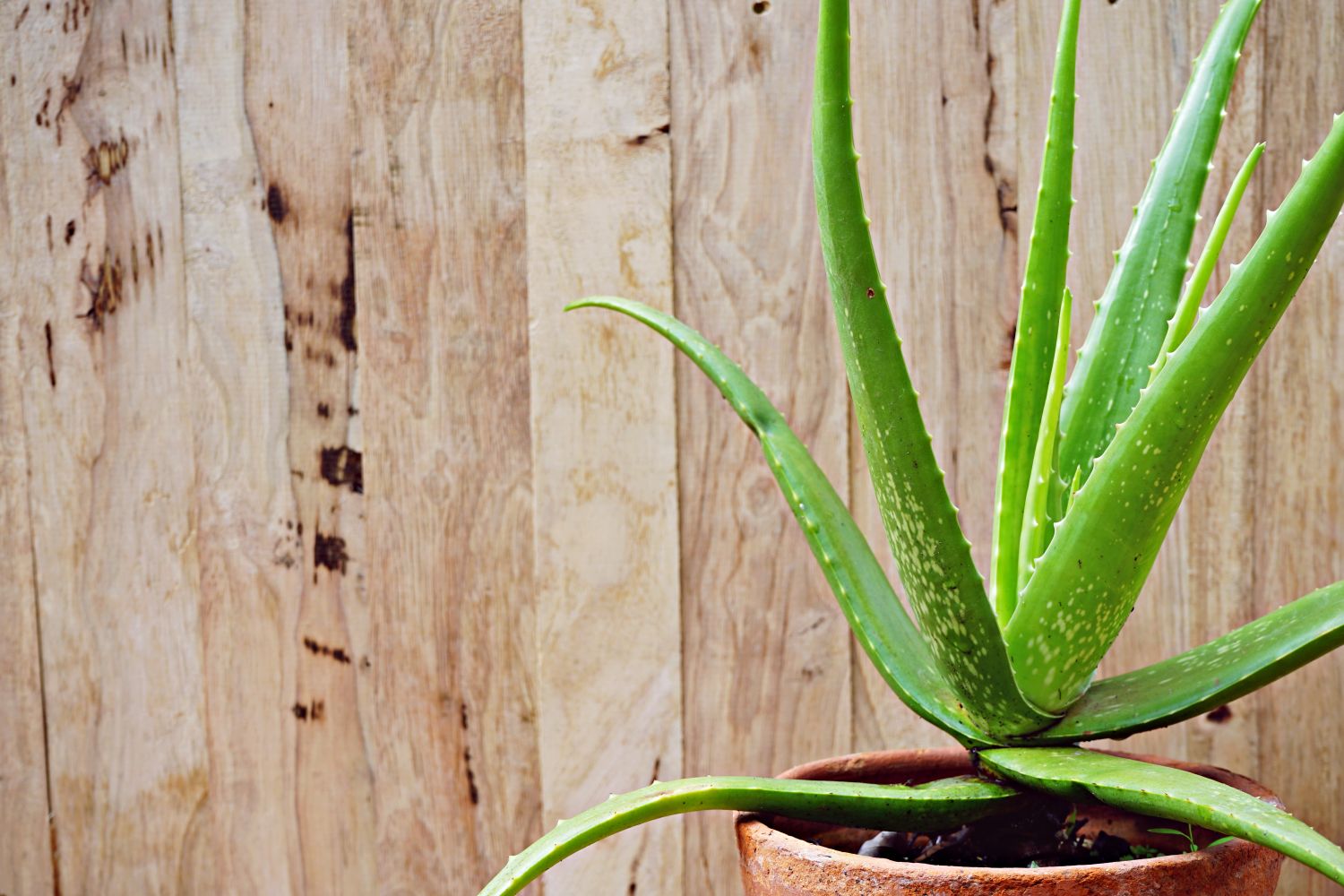
Aloe vera is a popular succulent plant, known not only for its healing properties but also for being an easy-to-care-for houseplant. Whether you’re looking to grow it indoors or outdoors, aloe vera thrives in hot, dry climates and requires very little maintenance. In this guide, we’ll show you the best tips and tricks for taking care of your aloe vera plant so that it remains healthy and thrives in your home or garden.
What Does Aloe Vera Look Like?

Aloe vera is a type of succulent that belongs to the Aloe genus, with over 300 species native to tropical and subtropical regions, including Africa, Madagascar, and India. The most commonly grown species is Aloe barbadensis miller, which is well-known for its thick, juicy green leaves containing a gel that offers various medicinal uses.
The plant has a short stem, and its thick leaves fan out from the center. The edges of the leaves are lined with small serrated teeth. When it blooms, aloe vera produces vibrant flowers that range from red to yellow, often growing at the top of the plant.
Here are a few popular varieties of aloe vera:
- Aloe ciliaris: A climbing variety that blooms bright orange flowers in the fall.
- Aloe striata (Coral Aloe): Known for its colorful leaves, it thrives in hot, dry climates.
- Aloe aristata (Lace Aloe): A clump-forming aloe with large orange flowers that attract pollinators.
- Aloe ferox: A hardy variety with medicinal properties that’s grown in various climates.
Benefits of Aloe Vera Gel
:max_bytes(150000):strip_icc()/GettyImages-1348473975-f9ac7d89066f41ff9e5bef3a752ff205.jpg)
Aloe vera gel has many healing and cosmetic benefits, such as:
- Healing sunburns
- Relieving diaper rash
- Aiding in weight loss when consumed as juice
- Soothing muscle pain
- Anti-fungal and anti-bacterial properties
- Improving oral health
- Fighting acne
- Boosting immunity
- Anti-aging effects when used in creams
Aloe Vera Plant Care Indoors
:max_bytes(150000):strip_icc()/_DSC58371-8b5a4db863f841afa1949d6ec65d7e2d.jpg)
How Big Do Aloe Vera Plants Get?
Aloe vera plants grow relatively slowly, taking 3–4 years to mature. Depending on the species, aloe plants can reach up to 3 feet tall and spread about 5 feet wide. They typically have around 22–25 leaves per plant.
When growing aloe vera indoors, it’s essential to place it in a location that gets bright, indirect sunlight. A spot near a south or east-facing window is ideal. If you live in a hot climate, some shade during the hottest parts of the day will help.
In USDA zones 9–10, aloe vera can be grown outdoors, but in cooler climates, it should be brought inside when temperatures dip below 50°F (10°C).
Best Soil for Aloe Vera

Aloe vera thrives in well-draining, sandy soil with a pH level between 7 and 8.5. Cactus or succulent potting mix is the best option, as it allows excess water to drain while retaining just enough moisture for the plant’s needs.
If you can’t find cactus soil, you can make your own by adding perlite, pumice, or coconut coir to regular potting soil. Be sure to use a terracotta pot with drainage holes, as this allows excess moisture to escape and helps prevent root rot.
How Often to Water Aloe Vera
:strip_icc()/BHG-aloe-plant_AEpit8vQK48AJiGDEUKe0R-c8115072ea6640b8bb5cd18049fed943.jpg)
Aloe vera is drought-tolerant and requires minimal watering. The key is to avoid overwatering, as this can lead to root rot. Water your aloe deeply but infrequently, and always ensure the top third of the soil is dry before watering again. In general, you’ll water it every 2–3 weeks during the growing season (spring and summer) and less often in the fall and winter.
To check if your aloe needs water, insert your finger into the soil. If it feels dry, it’s time to water. Water thoroughly and allow any excess water to drain out.
Does Aloe Vera Need Sunlight?

Aloe vera thrives in full sunlight when grown outdoors. Indoors, it needs plenty of bright, indirect light. If your aloe starts showing signs of stress—like brown, crispy edges—it might be getting too much direct sunlight. Conversely, if it’s growing tall and leggy, it may need more light.
Aloe vera grows best at temperatures between 55°F and 80°F (13°C and 27°C). Keep it indoors when temperatures drop below 50°F (10°C), and avoid exposing it to frost.
Fertilizing Aloe Vera

Aloe vera doesn’t need frequent fertilizing, but it will benefit from occasional feeding during its growing season. Fertilize once a month from April to September using a diluted liquid fertilizer or a slow-release option. A 15-30-15 fertilizer works well for aloe vera. In the winter months, you can skip fertilizing as the plant enters a dormant period.
For a more natural option, use organic compost or homemade compost tea. If you’re aiming to promote flowering, gentle feeding will support this process.
Aloe Vera Propagation
/how-to-propagate-aloe-vera-5087447-hero-32432ce03913495896fb2fc6295e0a58.jpg)
Aloe vera is easy to propagate using “pups” (plantlets) that grow at the base of the mother plant. Here’s how to propagate aloe vera:
- Remove the Pup: Wait until the pup is 2–3 inches tall before gently removing it from the parent plant.
- Plant the Pup: Place the pup in a small pot with well-draining soil.
- Water: Wait a couple of days before watering to let the plant settle in. Water lightly and keep it in bright, indirect light.
You can also propagate aloe vera from seeds, though it takes longer and requires more patience.
Replanting Aloe Vera

Aloe vera needs to be repotted if the plant becomes too large for its pot or the roots become overcrowded. The best time to repot is during the spring or summer when the plant is actively growing. Choose a pot that’s 2–4 inches larger than the current one, and be sure it has drainage holes.
When repotting, gently remove the plant from the old pot, trim any excess roots, and replant in fresh soil. If the plant has pups you don’t want to keep, you can remove them as well.
Troubleshooting Aloe Vera Problems

Aloe vera is relatively low-maintenance, but you might encounter a few common issues:
- Brown, Drooping Leaves: This is usually caused by overwatering, inadequate sunlight, or pest infestations. Check for pests like mealybugs or scales, and ensure the plant gets enough light.
- Root Rot: Caused by overwatering, root rot can be identified by wilting, yellowing, and mushy leaves. If your aloe shows these symptoms, remove it from the pot, trim off the damaged roots, and repot it in fresh, dry soil.
- Brown Tips: Brown tips, or “knobs,” often appear due to overwatering or excessive heat. You can trim these off with clean pruning shears.
Frequently Asked Questions (FAQs) About Aloe Vera
1. How much light does an aloe vera plant need?
- Aloe vera thrives in bright, indirect sunlight. A sunny windowsill is ideal, but it can also tolerate some direct sunlight. If growing it indoors, make sure it gets at least 6–8 hours of light per day.
2. How often should I water my aloe vera plant?
- Aloe vera plants are drought-tolerant and should be watered only when the soil is dry to the touch. Typically, watering once every 2–3 weeks is enough. Be sure to avoid overwatering, as this can lead to root rot.
3. Can I grow aloe vera indoors?
- Yes! Aloe vera makes a great indoor plant. Just make sure it gets plenty of light and that the pot has good drainage to prevent overwatering.
4. How do I know when my aloe vera plant needs water?
- Aloe vera plants are very drought-tolerant, so it’s important to check the soil regularly. If the top 1–2 inches of soil is dry, it’s time to water. If the leaves start to look wrinkled or limp, that’s another sign that your plant may be thirsty.
5. Can I use aloe vera on my skin?
- Yes, aloe vera gel is often used for its soothing properties. It can help with sunburns, minor burns, and dry skin. Just break off a leaf, slice it open, and apply the gel directly to the skin.
6. How do I propagate my aloe vera plant?
- Aloe vera can be propagated through its “pups,” which are small offshoots that grow at the base of the plant. Gently remove the pup, ensuring it has roots, and plant it in its own pot with well-draining soil.
7. Can aloe vera survive in cold temperatures?
- Aloe vera is sensitive to cold and should be kept in temperatures above 50°F (10°C). If you live in a region with colder winters, it’s best to bring your aloe vera indoors during the colder months.
8. What kind of soil is best for aloe vera?
- Aloe vera prefers well-draining soil, such as cactus or succulent mix. You can also mix regular potting soil with sand or perlite to improve drainage.
9. How do I prevent my aloe vera plant from becoming too leggy?
- If your aloe vera plant becomes leggy (tall and spindly), it may not be getting enough light. Move it to a sunnier spot and trim back any leggy growth to encourage new, healthier growth.
10. Can I eat aloe vera?
- Aloe vera gel is edible, but it must be prepared correctly. The outer skin of the leaf is not safe to eat, so carefully peel it and consume only the clear gel inside. However, some people may experience digestive discomfort, so it’s best to consult a healthcare professional before consuming aloe vera.
Conclusion
Aloe vera is a resilient and low-maintenance plant that offers a wide range of benefits for both health and home decor. With the right care—such as providing sufficient light, water, and well-draining soil—you can easily grow a thriving aloe vera plant. Whether you’re using it for its soothing gel or simply appreciating its beauty, this versatile succulent will be a rewarding addition to your home or garden. Happy gardening and enjoy the many uses of aloe vera!

